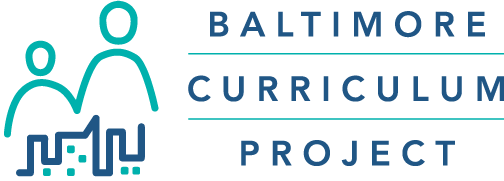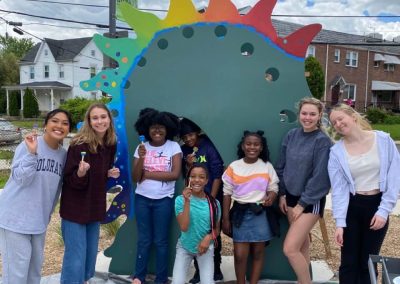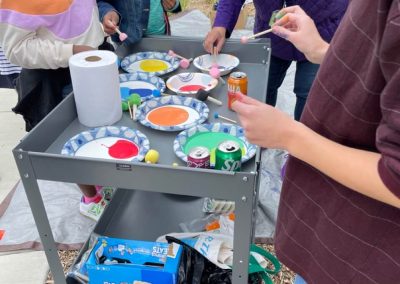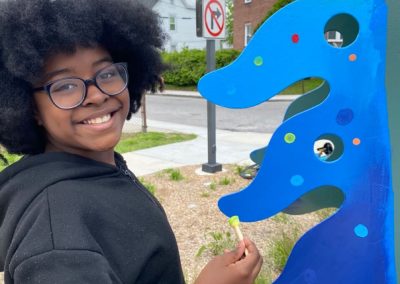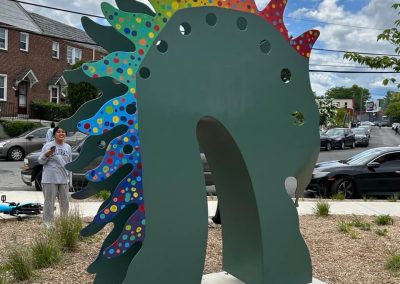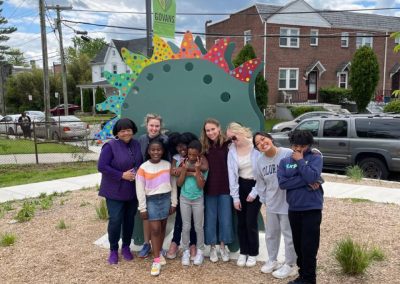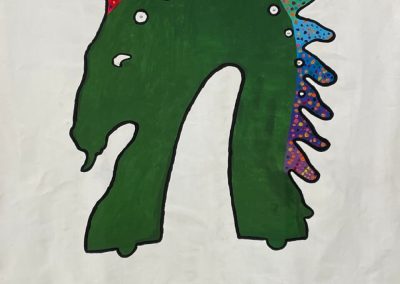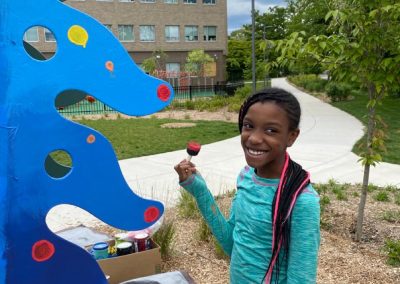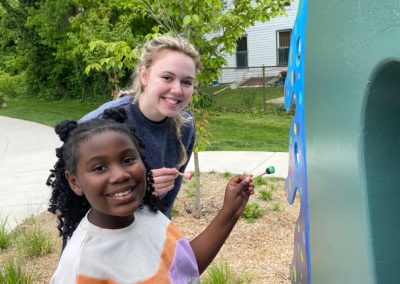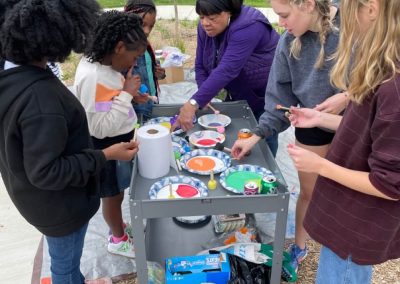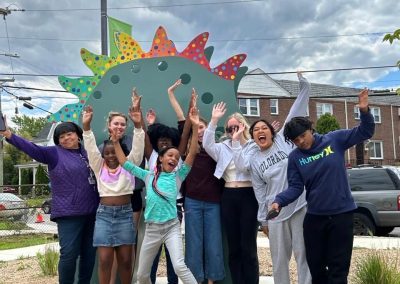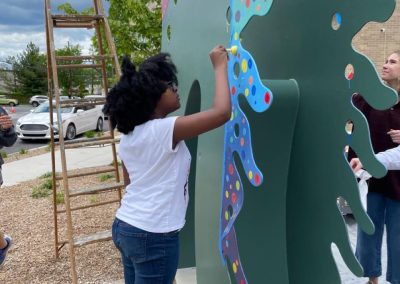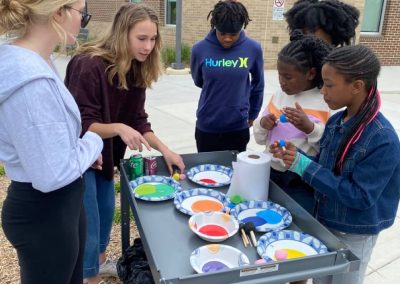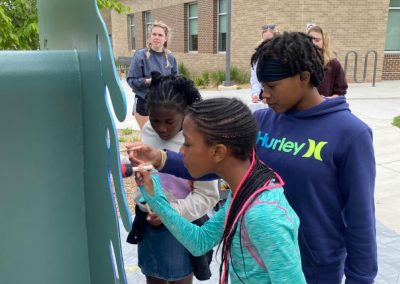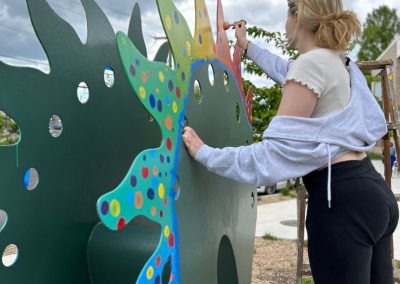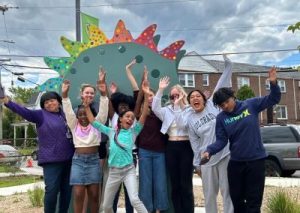 Maryland is known across the globe for thoroughbred racing. And the newly painted, modern horse sculpture in front of the Govans Elementary School building has the provenance befitting the state and sport.
Maryland is known across the globe for thoroughbred racing. And the newly painted, modern horse sculpture in front of the Govans Elementary School building has the provenance befitting the state and sport.
The iconic sculpture, “The Of Course Culture Horse” by Stan Edmister, was built in 1980. For decades, it proudly stood watch over the original Govans school building and the new, state-of-the-art school City school building, which was built in 2021 through the Baltimore City Public Schools’ 21st Century Schools Program. Edmister, a well-known playground designer, sculptor, and lover of color, led the City in repainting its bridges in colorful hues.
The colorful reincarnation of the Govans horse sculpture honors that legacy and celebrates the exuberant spirit of the school. The artists collaborating on this exciting public art project were four
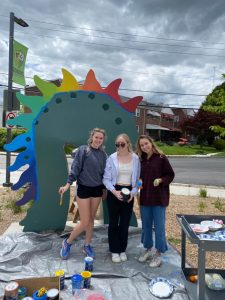
budding artists at Govans Elementary School, a Baltimore Curriculum Project (BCP) neighborhood conversion charter school, and four public-art enthusiasts at Loyola University of Maryland.
In March, Marianna Molloy, Brooke Scotti, Eliza Snyder, and Fatima Velasco — all were students in Loyola’s spring 2023 Public Art course taught by interdisciplinary artist Billy Friebele, Associate Professor of Art at Loyola – began working with four Govans’ 4th and 5th graders, Je-Che, Maliyah, Mackenzie, and Nyla, on the public art project.
Guided by Govans art teacher Michael Sferlazza, Sandi McFadden, Community School Director at Govans through Strong City Baltimore, and Friebele, Loyola students first collaborated with the Govans students to capture their design ideas for the sculpture. The group created free-flowing patterns and used beautiful colors to fill in designs.
While exploring designs, and making beautiful art, they began to bond with their art mentors, sharing personal stories, talking about the school day, sharing some about their hopes and dreams. The voices of the Govans students were being heard through these heart-warming conversations. As they sometimes say, the medium became the message.
The Loyola students were just as excited about the creative collaboration. “This is the first time I’ve volunteered in the community,” Eliza, a senior communications major, says. “We’ve helped the girls prep for the painting by talking about design, discovering what they like best about design, and leading some activities around horses. It’s been a great experience!”
Friebele is equally pleased with the collaboration. “A core goal of the Public Art service-learning course is to respond to the needs of community partners with creativity and compassion,” he says. “To accomplish this, the students set up a series of structured lesson plans to foster creative exchanges. Rather than come into the project with a preconceived notion of how it should look, the design emerged collaboratively out of ongoing creative conversations between the Loyola students and Govans Elementary students.”
Why a Rainbow Mane?
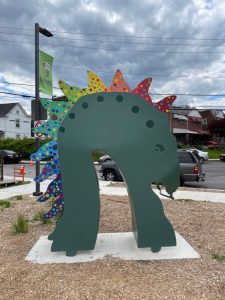 What did this group of young girls like best about design? Color! The newly painted horse sculpture does not disappoint, with its polka-dotted, rainbow-colored mane in colors chosen by the Govans’ students. Before the students could paint the statue, the Baltimore City Public Schools’ facilities crew removed lead paint from the structure, painted the statue with lead-free green paint, creating a base coat for the brightly colored mane.
What did this group of young girls like best about design? Color! The newly painted horse sculpture does not disappoint, with its polka-dotted, rainbow-colored mane in colors chosen by the Govans’ students. Before the students could paint the statue, the Baltimore City Public Schools’ facilities crew removed lead paint from the structure, painted the statue with lead-free green paint, creating a base coat for the brightly colored mane.
On May 5, the team put the finishing touches on the statue with different size and colored polka dots. With the college students tackling any embellishments that required a ladder, the Govans’ students enthusiastically dabbed dots of orange, teal, purple and other colors. Students were encouraged to spread their creative wings, and they did just that. The result is a beautiful rainbow of color and designs.
Govans’ Public Art Projects With the Baltimore City Public Art Commission
The horse statue was Govans’ first public art project, which was generously subsidized entirely by Loyola University Maryland’s Center for Community, Service, and Justice. The project received city-wide recognition with its selection as part of the Baltimore City Public Art Commission (PAC), which helps to administer Baltimore’s Percent-for-Public-Art program through which the City allocates 1% of all capital construction costs to go towards “the selection, acquisition, commissioning, fabrication, placement, installation, display and maintenance of public fine artwork.” Blaine Lipski, BCP’s Operations Manager,
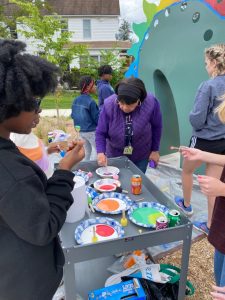
presented the horse statue and its history to the PAC. The project also was highlighted in the spring 2023 Baltimore Office of Promotion and the Arts Newsletter.
This is the first of two public art projects between Govans Elementary and Loyola. Just prior to the pandemic, Govans students worked on another Loyola public art project to create 26 beautiful mosaic stepping stones to be used in a community memorial garden in the Govans’ area, 14-acre Dewees Park, in honor of slain former City Councilman, Kenneth Harris.
The project stalled due to the pandemic and organizational changes in the Baltimore City Department of Recreation and Parks, but today, the project is forging ahead. The Department has installed a new Futsal Court for soccer and is working to install a playground, the memorial garden with the Govans’ students’ artwork, a walking trail around the park, and a basketball court for smaller children.
Govans children and families will greatly benefit from these projects since the park is walking distance from the school. It’s a great collaboration.
A Few Facts About Public Art in Baltimore:
Baltimore is the second city in the U.S. to implement a PAC.
Baltimore has more public statues and monuments per capita than any other city in the country.
The nine-member PAC managed the Govans project and is currently managing the restoration of the Colossus I sculpture outside the Waxter Senior Center in Mount Vernon.
The City of Baltimore owns 690 pieces of public art, some of which are over 230 years old.
And, yes, the rainbow-colored horse now looks a little like a dragon to some art patrons; fitting, since the dragon is the Govans’ school mascot.
